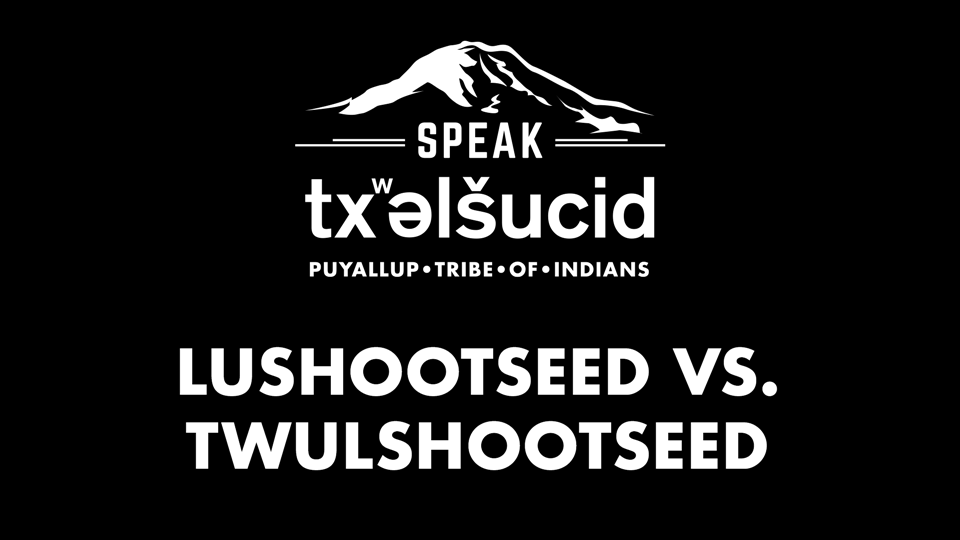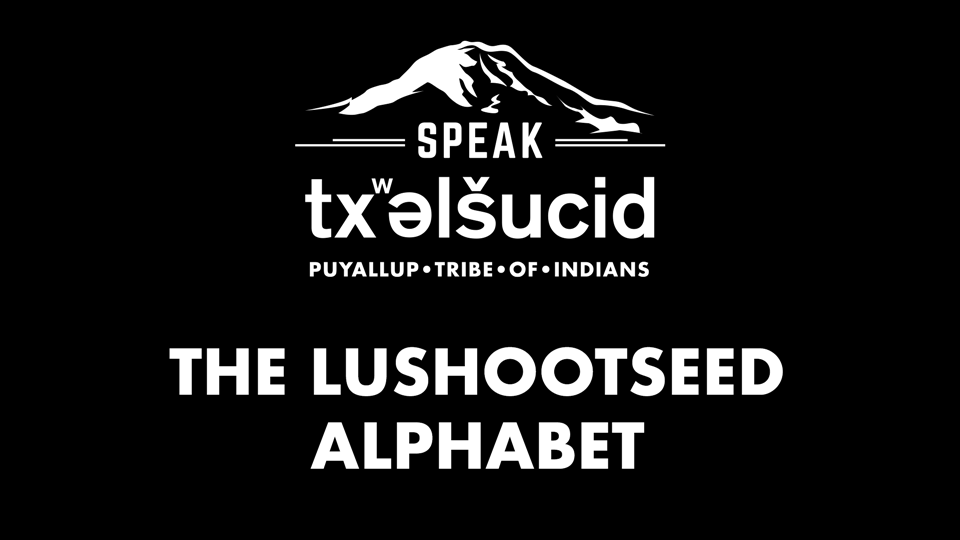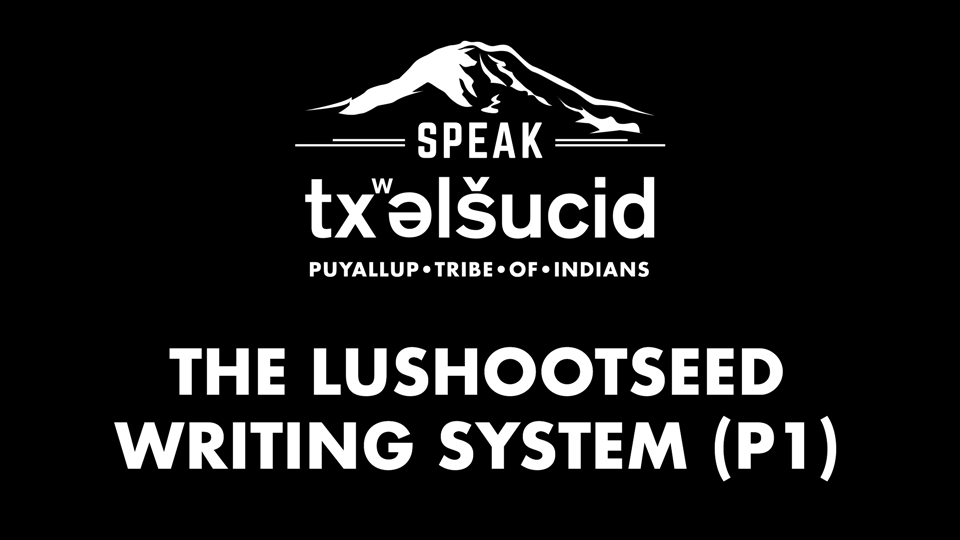ABOUT TWULSHOOTSEED
ʔabshəliʔ ti txʷəlšucid - Lushootseed lives. Here is an in depth look at the Lushootseed language. The what, where, when and everything else about our ancestral language.
How much do you know about Lushootseed? Download the Lushootseed Quiz Here!

Lushootseed Vs. Twulshootseed
There are 13 different tribes in the Puget Sound region in Washington state that speak Lushootseed. It is all the same language however there are dialectal differences. The predominate ones are Northern and Southern. The Puyallup tribe speaks Southern Lushootseed and in that dialect we call Lushootseed - txʷəlšucid. Linguist Thom Hess coined the term Lushootseed. He took our word dxʷlušucid, dropped the dxʷ- prefix and called it Lushootseed. This was easier for non-Lushootseed speakers to say. It references all of our language. Each tribe calls our language something different. Some call our language xʷəlšucid, dxʷlušucid and txʷəlšucid. Some call it their tribal language, suq́ʷabšucid - Suquamish language. And some of our elders called it speaking Indian.

The Lushootseed Language Family
Today we are going to go over our language family. We at the Puyallup Tribe speak Lushootseed along with 12 other tribes in the Puget Sound region in Washington State. Our language falls under the Salish language family. This covers areas of Canada, Washington, Oregon, Idaho and Montana, and includes 23 languages. Languages in our family have enough similarities such as vocabulary, grammar and even sentence structure between all of them, that linguists are reasonably sure that these languages share a common ancestral language they call Proto-Salish. For a more recognizable example, the Romance language family that derives from Latin consists of Italian, French, Spanish, Portuguese and Romanian. And just to clarify, we are in the Salish language family, but the Salish language is spoken by the Kalispel and Salish Tribes from eastern Washington, Idaho and Montana. We hope this is helpful information and helps to clarify the relationship between the terms Lushootseed and Salish in regards to our language family.

The Lushootseed Alphabet
Today I want to explain how the Lushootseed alphabet came into existence and why we don't change it. Starting in the 1960's, Lushootseed first language speaking elders worked with Linguist Thom Hess on the Lushootseed language. These elders included speakers from the Northern and Southern dialects of Lushootseed. Several of the elders agreed upon the current alphabet system that we use today that consists of 43 characters. Each letter represents one sound. Some of our alphabet consists of English sounds, however there are 18 sounds that do not exist in English, therefore the English alphabet is not capable of expressing non-English sounds. Our Lushootseed speaking elders made it very clear that they did not want this system changed. They stressed the importance of keeping our alphabet the way it is. This is why we do not provide phonetic or anglicized spellings of our language. We do however, provide lots of materials, videos and explanations of how to learn our language and how to produce the sounds.

The Lushootseed Writing System Part 1
Today, we're gonna go over some basics in the Lushootseed writing system. Number 1: there are no capital letters in the Lushootseed writing system including letters at the beginning of sentences. So cap locks and cap fonts do not work with Lushootseed. Number 2: if you're looking through the Lushootseed dictionary, you're going to see stress markers, root markers and dashes that come before and after a prefix or suffix. When writing Lushootseed, we don't use any of these symbols. Number 3: When typing Lushootseed, there are only a few fonts that support our alphabet. Fonts that don't support Lushootseed will skew our letters making them incorrect. This is why we are huge sticklers when it comes to proofing Lushootseed materials that come out of our office. This includes Lushootseed on posters, shirts, newspapers, etc. Lushootseed is spoken by 13 tribes in the Puget Sound region and we would like to uphold the integrity of our ancestral language as best we can.

The Lushootseed Writing System Part 2
Today, we're gonna go over some more basics about the Lushootseed writing system. Number 1: we do not use the question mark punctuation, instead we have questions words and a question marker that let us know that a sentence is a question. Number 2: We put letters within parentheses that are silent, the same way English uses an apostrophe for silent letters, for example in the word “isn’t” and “doesn’t”, where the apostrophe represents a silent o. We hope this information was helpful in understanding our writing system for those of you that don’t speak our ancestral language and want to learn more!

LUSHOOTSEED
Lushootseed is the language spoken by tribes living and around the Puget Sound region. Its borders extend to: Skagit Valley and Whidbey Island to the north; the east side of Kitsap Peninsula to the west; the drainage basin of South Puget Sound to the south; and the crest of the Cascade Mountains form Mt. Rainer to Mt. Baker to the north .
The names for Lushootseed varies between the tribes. They include:
- dxʷləšucid for the Tulalip/Snohomish and all other Lushootseed tribes to the north
- xʷəlšucid for Muckleshoot and Snoqualmie
- txʷəlšucid for all other tribes
Some people did not use these names. Rather, they just used the name of the tribe, e.g., suq’ʷabšucid ‘Suquamish language’. Others just referred to it as ‘Indian’, e.g.,
The term ‘Lushootseed’ was coined by Thom Hess. It is from the name dxʷləšucid. The dxʷ- prefix was removed to make it easier for non-Lushootseed speakers to pronounce. This is the most accepted name by the linguistic community. Other known terms for Lushootseed are Puget Salish and Puget Sound Salish (said by a few).
Lushootseed shares borders with Halkomelem, Nooksack and Strait Salish to the north; Klallam, Twana and Satsop to the west; Upper Chehalis and Cowlitz to the south; and Thompson, Columbian and Sahaptin to the east.
It’s not unusual for elders who speak their languages to say that the language came from the land. Vi taqʷšəblu Hilbert said:
“tul’al tu···diʔ tusqʷiq’ʷ ʔə kʷi ʔaciłtalbixʷ tul’al tiʔəʔ swatixʷtəd łaq’atəb ʔə kʷ x̌ax̌aʔ šəq siʔab tiʔəʔ ʔaciłtalbixʷ… ləc’ugʷagʷəd tiʔəʔ swatixʷtəd. ləc’ugʷagəd tiʔəʔ tatačulbixʷ. ləc’ugʷagəd tiʔəʔ čitčalbixʷ. ləgʷagəd tiʔəʔ bək’ʷ stab.”
“It [Lushootseed] is from the beginning strength of the people, and it is from what the Creator put down upon this land for people…. The earth speaks. The animals speak. Everything has a voice.” (Hilbert, Vi. et. al. Grandmother Video Project. MS:90)
Indeed, much of our vocabulary for animals clearly reflect the sounds that they make. This is most obvious with the birds. Examples are: k’aʔk’aʔ ‘crow’, kyuuqs ‘seagul’ (NL), skaykay ‘Steller blue jay’, spicx̌ʷ ‘sparrow’, and skʷaqʷ ‘raven’.
Elements also speak their name. Examples are
x̌ʷəlč··· is heard as the waves wash onto the shores:
ʔux̌ʷəlč ‘The sound of saltwater waves washing onto the beach.’
The sound tuləkʷ can be heard as the water pours over the rocks of a river:
‘tuləkʷ tuləkʷ tuləkʷ…’
šəxʷ can be heard as the wind blows.
The sound qəlb is made when rain hits the side of the house.
Next time you drive in a hail storm, listen to sound the hail makes as it
bounces off your car. You are likely to hear ƛ̓əbx̌ʷəlaʔ.
Take two rocks and hit them together. You will hear the word for rock,
č’əƛ̓əʔ or č’ƛ̓aʔ
Hit two sticks together. You will hear, t’əkʷ’, t’ək’ʷ, the root of
st’əkʷəb.
The sound baqʷuʔ can be heard as you walk on fresh, wet snow.
Here are some examples of what animals say in Lushootseed:
łəgʷłəgʷiləb ti wiw’su
‘Leave the children. ’ (Martha Lamont)
ʔəxʷslək’ʷədəb čəd ti wiw’su
‘I want to eat the children.’ (Said by Owl Woman, a.k.a, Basket Ogress)
qlitxʷaʔ
‘red salmon berry’ (said by the robin in the spring, calling for the red
salmon berries to get ripe – Earnest Barr)
didiʔł ʔəsx̌ix̌ic’
‘It’s still a little not ripe.’ (said in the spring until the berries are
ripe)
k’ʷədi···cut
‘pray’
There are many other countless examples of how nature speaks Lushootseed. Next time you’re outside, turn on your Lushootseed ears and just listen. You will be surprised as to how prevalent Lushootseed is spoken everyday in the Puget Sound region.
Linguists have another view. If we observe language over time, we can appreciate changes that occur. Indeed, just within American English, changes in pronunciation are apparent, such as:
- soda versus pop for a ‘carbonated soft drink’
- Washington versus Warshington for ‘Washington State’
- y’all versus you for 3rd-person plural
- The loss of /r/ in Boston English, e.g., caw versus car for ‘car’
- Caught versus cot, and Don versus dawn are still separate words in dialects of the Mid-West, while on the West Coast dialects have merged these words into ‘cŏt’ and ‘dŏn’ .
 If the growth of a dialect is not interrupted (e.g., laws, war, social
pressures), it is possible for it to become a new language. For example,
the Romance language family consists of Italian, French, Spanish,
Portuguese and Romanian. These languages all derived from Latin. Since they
share Latin as a common ancestor, then it is not surprising that these
languages share similarities, such as vocabulary, grammar and even sentence
structures. Romance languages belong to larger family of languages called
Indo-European.
If the growth of a dialect is not interrupted (e.g., laws, war, social
pressures), it is possible for it to become a new language. For example,
the Romance language family consists of Italian, French, Spanish,
Portuguese and Romanian. These languages all derived from Latin. Since they
share Latin as a common ancestor, then it is not surprising that these
languages share similarities, such as vocabulary, grammar and even sentence
structures. Romance languages belong to larger family of languages called
Indo-European.
Like Romance languages, Lushootseed is closely related to several other languages. They share many similarities, and just like Romance Languages, Lushootseed and these languages have a common ancestral language called Central Salish. Central Salish is a branch of the Salish language family.
Here is a diagram of the Salish language tree. The Coast Salish language branches are: Bella Coola to the north, Central Salish, Tsamosan and Tillamook in Oregon. Interior Salish is on the east side of the Cascade Mountain range. It is divided into 2 branches: Northern and Southern Interior.
The Salish language family is comprised of 23 North American languages that extend from Canada to Oregon and from the Pacific Ocean east into Montana. These languages have enough similarities between them that linguists are reasonably sure that these languages share a common ancestral language they call Proto-Salish.



(Hillary Rudd, 2004 http://journals.hil.unb.ca/index.php/mcr/article/view/21406/24805)
Lushootseed was originally spoken by several groups. The Northern groups included: Swinomish, Skagit, Upper Skagit, Sauk-Suiattle, Stillaguamish, Snohomish and Skykomish. The Southern groups include: Suquamish, Duwamish, Snoqualmie, Puyallup, Nisqually and Squaxin. The two primary dialects of Lushootseed are Northern Lushootseed and Southern Lushootseed. The boundary between the two dialects is roughly the Snohomish and King County lines north of Seattle.
The primary sound differences between Northern and Southern Lushootseed involve the pronunciation of the two vowels /i/ and /u/. Northern Lushootseed tends to say a long-E for /i/ and a long-U (as in cute) for /u/ more often than Southern Lushootseed. Southern Lushootseed tends to say a long-A for /i/ and long-O for/u/ more often than Northern Lushootseed. This is not absolute. Snoqualmie and Muckleshoot (xʷəlšucid) prefer a long-E pronunciation for ʔi ‘yes’, where the rest of Southern Lushootseed speakers prefer a long-A. For Northern Lushootseed, long-U for stubš is said by some, while others prefer a long-O.
Northern Lushootseed uses the term tiʔił ‘that’. Southern Lushootseed uses tiʔił only when it follows the first word of a sentence, such as ‘that is… ’ sentences. E.g.,
It is pronounced tiił (without a /ʔ/ between the two /ii/) in all other forms. Note: this is a key marker between Northern and Southern Lushootseed.
tiʔəʔ or ti means ‘this’. Northern Lushootseed uses both tiʔəʔ and ti. Southern Lushootseed does not use tiʔəʔ. It only uses ti. The same is true for tsiʔəʔ and tsi ‘feminine this’. Northern Lushootseed uses both tsiʔəʔ and tsi. Southern Lushootseed does not use tsiʔəʔ. It only uses tsi. Note: these are two more key markers between Northern and Southern Lushootseed.
Northern Lushootseed tends to stress the second syllable of word. Southern Lushootseed tends to stress the first syllable of a word.
Table 1: examples of differences in stress
| Northern Lushootseed | Southern Lushootseed |
| 1. bədáʔ | bə́dəʔ ‘one’s own child’ |
| 2. sqʷəbáyʔ | sqʷábayʔ/sqʷúbayʔ ‘dog’ |
| 3. dəč’uʔ | də́č’uʔ ‘one’ |
| 4. kʷədád | kʷə́dəd ‘take, catch’ |
| 5. ʔəcá | ʔə́cə ‘I’ |
| 6. dəgʷí | də́gʷi ‘you’ |
There are words that appear to be the same, but are said a little bit differently. Below are examples of minor sound changes for the same word.
Table 2: examples of minor sound changes
| Northern Lushootseed | Southern Lushootseed |
| 1. č’áč’as | č’áč’aš ‘child’ |
| 2. q’íqx̌ʷuʔ | q’ə́q’x̌ʷuʔ ‘short’ |
| 3. kiáʔ | káyəʔ ‘grandmother’ |
| 4. biác | báyac |
| 5. dᶻakʷ | dᶻax̌ʷ ‘shake, rock’ |
| 6. łəx̌ʷúb | łəx̌úb ‘hunt’ |
Some of the words have loss of sounds in Southern Lushootseed. (In examples below, where the /l/ is in paranthesis, the /l/ is optional in Southern Lushootseed.)
Table 3: examples of sound loss
| Northern Lushootseed | Southern Lushootseed |
| 1. ʔəpús | pus |
| 2. ʔəx̌íd | x̌id ‘how’ |
| 3. sləx̌íl | slə́x̌i(l) |
| 4. słáx̌il | słáx̌i(l) |
| 5. łəčíl | łə́či(l) |
A number of words are different between Northern and Southern Lushootseed.
Table 4: examples different words for the same thing
| Northern Lushootseed | Southern Lushootseed |
| 1. sʔuládxʷ | sčədádxʷ ‘salmon’ |
| 2. yəláʔc | d’əláčiʔ ‘six’ |
| 3. yúbəč | sác’əb ‘king salmon’ |
| 4. bə́ščəb | c’bə́lqid ‘mink’ |
| 5. c’ə́bəb | kʷil ‘pick berries’ |
| 6. qʷəłáyʔ | st’ə́k’ʷəb ‘stick, log’ |
| 7. saʔ | qələ́b ‘bad’ |
Although the two primary dialects are Northern and Southern Lushootseed, it is also recognized that there minor dialectal differences between groups within Northern Lushootseed.
Table 5: examples of differences within Northern Lushootseed
| Northern Lushootseed | Specific group |
| 1. sčə́txʷəd | spaʔc (Skagit) ‘black bear’ |
| 2. stəgʷád | dᶻətgʷád (Skagit) ‘salmonberry’ |
| 3. skʷxʷíc | sq’əčqs (Skagit) ‘silver salmon’ |
| 4. k’ʷíč’id | q’ʷə́x̌ʷəd (Skagit) ‘butcher’ |
| 5. łəx̌ʷúb | šáyil (Skagit, Sauk-Suiattle) ‘hunt’ |
| 6. dəč’úʔ | č’uʔ (some dialects of Tulalip) ‘one’ |
The same is true for Southern Lushootseed groups.
Table 6: examples of differences within Southern Lushootseed
| Southern Lushootseed | Specific group |
| 1. sác’əb | yúbəč (Suquamish) |
| 2. hísk’ʷuʔ | hík’ʷuʔ (Suquamish) ‘thank you’ to a female |
| 3. híšəbaʔ | híma (Suquamish) ‘thank you’ to a male |
| 4. ʔaʔútx̌s (most groups) | sʔútx̌s (Muckleshoot) ‘Nootka style of canoe’ |
This is just a few examples of the vast diversity that can be appreciated in Lushootseed. There are several other differences that include such things as grammar, rate of speech, and even sentence structure. Elders said that each group had their own way of speaking. By the way someone spoke, you could identify where they were from, meaning dialect was part of identity. Regardless of how people spoke, the beloved elders were and still are very insistent that all dialects of Lushootseed were mutually intelligible and they were all part of the same language. Furthermore, the elders felt strongly that all dialects of Lushootseed were to be honored, regardless of where the speaker was from. This view of honor and respect is one of the most beautiful and precious values of the Lushootseed heart that extends beyond language into all other aspects of life. It reflects the ideas of ƛ̓ububƛ̓ub, kʷaxʷalikʷ, ʔabalikʷ ‘Be kind, be helpful, be sharing’, which are basic virtues of Lushootseed culture.
